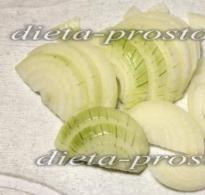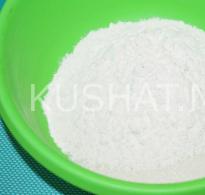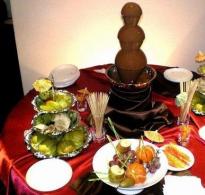_____ the secret of cooking a real kazy ______. Survival menu: Kazy-karta - special horsemeat sausage
And today, when there are almost no nomads left, for their descendants - Kazakhs, Turkmens, Mongols, Yakuts - this meat is still the basis of the table.
The secret is simple: for a long time horse meat was the most affordable meat in Central Asia. Today, horse meat dishes are still popular.
Cooking features
Horse meat - therefore, the younger the horse was, the more valuable its meat. The most delicious is the meat of 2-3 year old horses, and the meat of one year old foals is most valued. To distinguish the meat of an adult horse from a foal, look at the color of the fat. The younger the horse, the lighter her fat, in foals it is almost white, slightly pinkish, and in adults it is yellow.
To soften the meat, it must be marinated or smoked, and then boiled. Pretty long. Then it turns out soft and tasty. A bit like beef, only sweeter.
Kazy
Perhaps the most famous horse meat delicacy. Almost all Turkic peoples prepare it. Kazy can be eaten as a cold appetizer, or you can cook pilaf, besbarmak and other dishes from it. Usually kazy is cooked in late autumn. At this time, horses are slaughtered for the winter, because after the summer and autumn they are overweight and fatten up.
For kazy, a rib with meat and a strip of fat is taken. Moreover, a whole rib - from the spine to the sternum, 60-70 cm long. The ribs are covered with salt and in their own juice for 2-3 days. And then they soak. Only after that, the meat for kazy is covered with spices or garlic and placed in a thoroughly washed intestine - a card. It turns out a curved sausage kazy-karta. Now they began to lay in kazy meat cut from the rib along with fat. But it happens that the meat is put together with the rib, as in the classic version.
Each housewife in Kazakhstan has her own recipe for spicy mixtures for kazy and protects it from prying eyes. Washed intestines are stuffed with prepared meat. Tie the ends of the sausages and simmer for at least 2.5 hours. And then they hang it in a cool place where kazy can be stored for quite a long time.
Stewed horse meat in Tatar style
300 g horsemeat
2 tsp butter
1 bulb
300 g potatoes
Mustard, salt, pepper
Step 1. Cut horse meat into small pieces.
Step 2 Sprinkle each piece with salt, pepper, grease with mustard and keep in the cold for 30-40 minutes until the spices are absorbed into the meat.
Step 3 Fry the pieces of meat in a very hot frying pan with fat, then transfer to a saucepan, add broth or boiling water and simmer.
Step 4 Separately, boil, fry or bake large potatoes, put them in a saucepan with meat, add Tatar vegetable sauce and simmer until tender.
Besbarmak
The name of this dish is translated as "five fingers". The fact is that from time immemorial it has been customary for the Central Asian peoples to eat with their hands. And until now, some especially beloved national dishes are eaten like this. Besbarmak (or beshbarmak) is a national dish of many nations: Kazakhs, Uzbeks, Kyrgyz, Tajiks. Often horse meat is replaced with lamb or beef.
Bouillon
1.5 kg horsemeat
1 bulb
Salt, spices
Dough
2 cups of flour
0.5 cups of water
1 tsp salt
Sauce
1 bowl of broth
2 onions
Step 1. Rinse the meat and lower it into a cauldron with cold water, bring to a boil, reduce the fire and cook, removing the foam, for at least two hours.
Step 2 Knead the dough, let it stand for 30-40 minutes, then roll it into a layer 1-1.5 mm thick and cut into squares of 7-8 cm.
Step 3 30-40 minutes before the end of cooking, add salt to taste, bay leaf, onion, black peppercorns to the broth.
Step 4 Make sauce. Place chopped onion, salt, pepper, spicy greens in a separate bowl, pour over the fat removed from the hot broth, close the lid tightly and simmer.
Step 5 Dip the dough into the boiling broth and cook until tender. Then put the noodles on a flat dish.
Step 6 Put pieces of meat on top, and onion stewed in fat on it.
Shuzhyk
1 kg horsemeat
1 kg internal fat
3 tbsp salt
1 tsp black pepper
Garlic - optional
Step 1. Rinse the meat, rub with salt and keep for 1-2 days in a cool place at 3-4C.
Step 2 Rinse the intestines and soak in salt water.
Step 3 Finely chop the meat and fat and mix. Add garlic, pepper and salt and mix again.
Step 4 Fill the intestines with this mixture, tie both ends with twine, hang for 3-4 hours in a cool place.
Step 5 Smoke over thick smoke for 12-18 hours, then dry at 12C for 2-3 days.
Step 6 Then cook over low heat for at least 2.5 hours.
Dried horse meat
Horse peritoneum
Step 1. Meat cut into squares of 20 cm. Grate with salt, sprinkle with pepper.
Step 2 Put for salting in a dark cool place for 7-8 days.
Step 3 Then strung on twine and hang for 2-3 months in a dark place for drying.
Horsemeat larded in Kyrgyz style
1 kg horsemeat
2 carrots
2 parsley roots
1 head of garlic
1 tbsp melted lard
1 bulb
1 pickle
Bay leaf
finely chopped parsley
Step 1. Stuff horse meat with carrots, parsley roots, garlic.
Step 2 Bandage the prepared pieces, fry until half cooked.
Step 3. Fry the onion in lard, put it to the meat, add bay leaf, pickled cucumber, diced. Add water and simmer over low heat until tender.
Kyzdyrma (Tatar cuisine)
1 kg horsemeat
50 g melted butter
Salt, pepper to taste
Step 1. Cut the meat into small pieces, salt, pepper and refrigerate for 3 hours.
Step 2 Then fry the meat in oil.
Step 3 For long-term storage, put kyzdyrma in a jar and pour melted butter over it. Put in the cold.
Yakut horse meat broth
1 kg horsemeat
1 tbsp fat
2 tbsp flour
1 bulb
Salt and pepper
Step 1. Rinse horse meat, put in a pot of cold water, bring to a boil. Remove the foam that has surfaced, season with salt and bring to a boil over medium heat.
Step 2 Sauté the onion.
Step 3 Put the finished meat on a dish, strain the broth and add the fried onions.
Step 4 Take a small amount of broth and cool slightly, put the rest of the broth on fire. In the cooled broth, dilute the flour without sautéing.
Step 5 Gradually add the broth with flour to the boiling broth, stirring constantly. Put a little pepper, sprinkle with chopped dill or parsley.
Step 6 Arrange horse meat on plates with vegetables, and serve the broth separately.
These meat delicacies are very loved by the Kazakh people and are truly the pearls of Kazakh cuisine due to their taste. Kazy-karta and zhal-zhaya are served on top of meat on beshbarmak as a sign of special disposition on special occasions. However, recently kazy-karta and zhal-zhaya are also served as a cold appetizer to the table. I can't help but notice that these meat delicacies are quite high-calorie and nutritious due to the method of preparation by salting and drying. A large amount of horse fat is well absorbed and warms in the cold season.
It is interesting that the Majilis members only recently became interested in the presence of a patent for the Kazakh national heritage. As it turned out, the patent for making koumiss belongs to a German citizen, and the patent for kazy belongs to the French. A patent for kazy was obtained at the beginning of the 20th century by wealthy Kazakhs who emigrated during the revolution.
Amirkhan Amanbaev, Vice Minister of Justice of the Republic of Kazakhstan:
“There is no danger for Kazakh national dishes, kymyz, kazy karta, irimshik. Don't worry, no one will get them. Because now, together with the Ministry of Culture to prepare bills, there is a list, they will be protected. This is a national treasure."
Kazy requires a whole ritual of preparation. To begin with, it must be taken into account that kazy is made from a specially fattened horse for 2-3 years. They are grazed and fattened like other livestock and are not given names like racehorses. Before slaughtering a horse, be sure to read a prayer and wash your hands. Slaughtering and butchering of cattle was carried out by specially trained people "kasapshy". The Kasapshis knew how to properly prepare cattle for slaughter, how to properly slaughter, how to remove the skin without damaging it, and how to properly butcher. The entrails and intestines have long been handled by women. The highly valuable intestines had to be washed in such a way that there was no smell left and in no way damaged.
After slaughter, meat with pieces of fat is cut off from the ribs of the carcass, although previously the meat was not separated from the ribs. The prepared meat is salted, peppered, if desired, finely chopped garlic is added. The meat is stuffed tightly into the intestine with your fingers, trying not to tear it. The ends of the kazy must be tied loosely so that the shell does not burst during cooking, or stabbed with toothpicks. Each housewife uses her own composition of the seasoning, which she keeps secret. For kazy, a special duodenum is used, 10-12 meters long. The kazy themselves are made 60-70 cm long. The finished kazy is hung out in a cool and ventilated place. In this form, it is stored for a long time, becoming even tastier.
Kazy can be boiled and served together with beshbarmak, or it can be served as an independent cold dish. Just remember that kazy is cooked for a long time, at least 2 hours and always on low heat, otherwise the shell may burst. Fat in kazy, of course, will partially dissolve in hot water. And kazy without tender fat layers melting in the mouth is no longer kazy.
Karta is the large intestine of a horse, turned inside out, fat inside. The large intestine is thoroughly washed alternately with cold, warm and salty water, salted, seasoned, and then turned out, trying not to damage the layer of fat. Sometimes the karta is stuffed with fatty meat and seasonings. Recently, the card is even stuffed with vegetables. The map cannot be stored for a long time, so they try to eat it fresh. Usually, the card is served for bass tabak along with kazy and special pieces of meat for beshbarmak. The card can also be served as an independent cold dish.
A sting is a submandibular fat deposit. When slaughtered, the stinger is cut out along with a thin piece of meat, notches are made, salted and peppered. After that, the sting is placed in a large container so that the salt soaks the fat well. Usually, salting takes up to 10 hours. The salted sting is hung out in a cool and ventilated place for several days. The sting is not consumed fresh, always dried or smoked. The dried sting is soaked for 2 hours in cold water before cooking. The boiled sting is cut into plates and decorated with herbs or onion rings.
Speaking "zhaya", the Kazakhs mean part of the femoral leg of the horse. To do this, the upper muscle layer about 10 cm thick is removed from the leg. And then almost the same method of salting, drying and drying is used, as for the sting. That is, zhaya is salted with a large amount of salt and left overnight in a bowl. Then they are dried and dried for several days in a cool and ventilated room. Ready zhai is either smoked or boiled immediately. Served over meat for beshbarmak, or as an independent cold dish.
Photo from www.allstor.ru
, Nogai cuisine , Tatar cuisine , Uzbek cuisine
see also
Write a review on the article "Kazy-karta"
Notes
Literature
- Pokhlebkin V.V.//National cuisines of our nations
- K. Mahmudov.. - Tashkent: Uzbekistan, 1976. - S.301.
- Yu.A. Akhmetzyanov, R. G. Mukhamedov, Kh. S. Bikbulatova, R. G. Ivanov- "Tatar cuisine" Kazan Tatar book publishing house, 1985-319 p. from ill.; 8l. incl.
Links
An excerpt characterizing the Kazy-karta
The rain had passed, only fog and drops of water fell from the branches of trees. Denisov, the esaul, and Petya silently followed the peasant in the cap, who, lightly and soundlessly stepping with his feet turned out in bast shoes over the roots and wet leaves, led them to the edge of the forest.
Coming out to the izvolok, the peasant paused, looked around and headed towards the thinning wall of trees. At a large oak tree, which had not yet shed its leaves, he stopped and mysteriously beckoned to him with his hand.
Denisov and Petya drove up to him. From the place where the peasant stopped, the French were visible. Now a spring field was going down behind the forest like a semi-hillock. To the right, across a steep ravine, one could see a small village and a manor house with collapsed roofs. In this village, in the manor house, and along the whole hillock, in the garden, by the wells and the pond, and along the entire road uphill from the bridge to the village, no more than two hundred sazhens away, crowds of people could be seen in the wavering fog. Their non-Russian cries were clearly heard at the horses in the carts tearing up the mountain and calls to each other.
“Give the prisoner here,” Denisop said quietly, not taking his eyes off the French.
The Cossack dismounted from his horse, removed the boy, and together with him approached Denisov. Denisov, pointing to the French, asked what kind of troops they were. The boy, thrusting his chilled hands into his pockets and raising his eyebrows, looked frightened at Denisov and, despite his apparent desire to say everything he knew, got confused in his answers and only confirmed what Denisov was asking. Denisov, frowning, turned away from him and turned to the esaul, telling him his thoughts.
Petya, turning his head with quick movements, glanced first at the drummer, then at Denisov, then at the esaul, then at the French in the village and on the road, trying not to miss something important.
- Pg "is coming, not pg" is Dolokhov, you have to bg "at! .. Huh?" Denisov said, his eyes flashing merrily.
“The place is convenient,” said the esaul.
“We’ll send infantry from below—by swamps,” Denisov continued, “they’ll crawl up to the garden; you will call with the Cossacks from there, ”Denisov pointed to the forest outside the village,“ and I’m from here, with my gusags.
“It won’t be possible in a hollow - it’s a quagmire,” said the esaul. - You will bog down the horses, you have to go around to the left ...
While they were talking in an undertone in this way, below, in the hollow from the pond, one shot clicked, smoke began to turn white, another, and a friendly, as if cheerful, cry of hundreds of voices of the French who were on the half-mountain was heard. In the first minute, both Denisov and the esaul leaned back. They were so close that it seemed to them that they were the cause of these shots and screams. But the shots and screams did not belong to them. Below, through the swamps, a man in something red was running. Obviously, the French were shooting at him and shouting at him.
- After all, this is our Tikhon, - said the esaul.
- He! they are!
“Eka rogue,” said Denisov.
- Leave! - screwing up his eyes, said the esaul.
The man whom they called Tikhon, running up to the river, flopped into it so that the spray flew, and, hiding for a moment, all black from the water, got out on all fours and ran on. The French, who were running after him, stopped.
- Well, clever, - said the esaul.
- What a beast! Denisov said with the same expression of annoyance. And what has he done so far?
- Who is this? Petya asked.
- This is our plast. I sent him to pick up the language.
“Ah, yes,” said Petya from Denisov’s first word, nodding his head as if he understood everything, although he decidedly did not understand a single word.
Tikhon Shcherbaty was one of the most needed people in the party. He was a peasant from Pokrovsky near Gzhatya. When, at the beginning of his actions, Denisov came to Pokrovskoye and, as always, calling the headman, asked what they knew about the French, the headman answered, as all the headmen answered, as if defending themselves, that they did not know anything, know they don't know. But when Denisov explained to them that his goal was to beat the French, and when he asked if the French had wandered into them, the headman said that there had been marauders for sure, but that in their village only Tishka Shcherbaty was engaged in these matters. Denisov ordered Tikhon to be called to him and, praising him for his activities, said a few words in front of the headman about the loyalty to the tsar and the fatherland and hatred for the French, which the sons of the fatherland should observe.
“We do no harm to the French,” said Tikhon, apparently timid at these words of Denisov. - We only so, means, on hunting dabbled with the guys. It’s like two dozen Miroderov were beaten, otherwise we didn’t do anything bad ... - The next day, when Denisov, completely forgetting about this peasant, left Pokrovsky, he was informed that Tikhon had stuck to the party and asked to be left with it. Denisov ordered to leave him.
Kazy - a traditional dish of the Kazakh people - is very famous not only in Kazakhstan, but also abroad.
A nutritious and tasty delicacy was appreciated, and today it is not only a dish for special occasions and large events, but also food for ordinary everyday life. Guests are greeted with a kazy, not a single wedding, funeral or commemoration is complete without a kazy ..
At home, kazy is usually prepared in late autumn or winter, when cattle are slaughtered and sogym is harvested. Since ancient times, preparations have been made at this time of the year for several reasons: meat is easier to store in winter; there will be something to eat during this period when nothing grows. This reason is related to the nomadic way of life of the Kazakhs, when there were no refrigerators and supermarkets. In addition, it is in autumn that livestock gains the most weight.
Horse meat is considered a healthy product - having a small amount of carbohydrates, meat is rich in valuable protein that is well absorbed - many times faster than beef. Horse meat is considered dietary and hypoallergenic meat. There is little cholesterol in horsemeat, and besides, there are vitamins, such as A, C, vitamins of group B, and this meat is also rich in iron. Horse fat does not freeze and even has a warming effect on the body, so from ancient times kazy were taken on the road, going to distant lands in winter.
For weddings, commemorations, funerals and other major events, it is supposed to use the meat of a horse specially fed with oats, which is kept in a dark place on a leash for several months. The meat is selected especially carefully, because if guests are served kazy from thin meat at crowded events, this can cause gossip and talk. Cooking kazy is an important matter, it is trusted only by experienced, older women in the family.
It is believed that thicker meat is an indicator not only of the goodness of the kazy, but also of the wealth of the treater. When meat is cut from a horse's rib, its thickness is measured in the amount of spruce - finger or sulfur - palm. The more fingers that fit on the slice, the better. Fatty, good meat is found in a middle-aged horse, but not in a young stallion.
Despite the fact that today you can buy meat at any time of the year, the custom of preparing sogym and making kazy in winter is still relevant today. Nevertheless, kazy can be found in the bazaar, in almost every restaurant offering national cuisine, in shops, and so on.
Shynar has been working at the Green Bazaar in Almaty for about 20 years, selling meat. They often turn to her to buy kazy - she already has, she says, regular customers. "New" customers come looking at the meat and also order.
Horsemeat Shynar is brought by wholesalers from Zharkent. The woman admits that Zharkent meat is very good, tasty, just like Shymkent meat. In order to cook kazy, you need to cut the meat from the ribs of the horse, and if it is very fatty, add a layer of zhay from the thigh. So tastier, but "prestigious" if there is more fat.
Shynar says that meat and fat are usually put in the ratio of 70% to 30%. Fat must be present, because without it, the woman explains, it is no longer a kazy, but a shuzhyk.
Then the meat must be salted, peppered and grated with minced garlic in a meat grinder. Before our eyes, Shynar puts a handful of garlic into a meat grinder. It happens that customers ask to put less garlic or do without it and pepper at all, then the meat is only salted.
After the meat has been rubbed with this mixture, they need to stuff horse intestines. The intestines are prepared in advance - they are thoroughly washed with salted water. Salt not only removes impurities better, but also removes mucus. For kazy, as a rule, they use a special duodenum from an adult horse, 10-12 meters long. Guts cost about five or six thousand tenge.
To prepare a kazy, a length of 50-60 centimeters is sufficient, but the necessary segments are cut off only at the end of the work. For example, one and a half meters of kazy - three segments - are approximately three kilograms. That is how much Shynar ordered from her regular client. The meat saleswoman says that today the customer has guests from Kokshetau, "and they know a lot there."
“Sometimes we make 50 kilograms, usually for restaurants. And clients take 3-5 kilograms. They take 20 kilograms for a wedding,” says Shynar.
Prepared meat, cut into even longitudinal stripes, is carefully stuffed into the intestine, trying not to tear it. Pieces of meat are carefully pushed inside, it seems as if the filling is sliding inside the shell. Cooking kazy, says Shynar, takes 10-20 minutes.
Periodically, the saleswoman levels the meat inside the intestine and pushes it a little further - so that the filling lies evenly.
“You need to put it well in the gut. Some twist the meat and it turns out ugly. The meat should be folded flat,” she explains. In addition, meat should be interspersed with fat in layers.
While Shynar fills her gut with meat, she talks about herself in few words.
“I come from Bakanas, Balkhash region. She came to Almaty in 1988. In general, I am a doctor by profession, I worked as a nurse in Kalkaman, then in the 12th hospital. She worked in a kindergarten for six months to arrange a child in a kindergarten. In 1995, I came to the market… Of course, it’s better here, but there is no money in the hospital, but here you always have cash…”.
After Shynar finishes stuffing the gut, she fastens the tip with a toothpick with a deft movement of her fingers, slightly breaking its tip so that the shell does not slip. Then he cuts off a piece, “sews up” it too. And there are three such pieces. Shynar cuts off the rest of the gut - it will go to the next portion of the kazy. And excess fat is cut off from the shell of the finished product.
It will be cooked at home - kazy is cooked for at least two and a half hours - beautifully cut and served to guests. It must be remembered that during cooking, the casing of the kazy - the intestine - must be pierced in several places. Otherwise, the intestine may burst.
A kilogram of kazy at the Green Bazaar costs 2,300 tenge. Previously, sellers say, a kilogram cost 2,500 tenge, but after the akim's arrival, traders were advised to lower the price. If wholesalers increase the cost of meat, they believe, sellers will have losses. However, traders hope that local meat will not rise in price.
In the long list of what to bring from Uzbekistan, kazy should come first! Moreover, the kazy has a unique feature - no matter how much you bring, it will still not be enough. Because this amazing meat delicacy you can eat endlessly, every day, for breakfast, lunch and dinner - and not get bored. Don't believe?
Kazy(accent on the last syllable) - homemade meat product, horse meat sausage, which has an indescribable aroma and delicate taste. Kazy - exclusively homemade sausage and is not manufactured on an industrial scale for export or for the purpose of mass sale in supermarkets, like, say, ordinary sausages, sausages, carbonate, and so on. Kazy is completely does not contain any chemical additives- concentrates and preservatives, "flavors identical to natural", dyes and artificial casings. This sausage is made from fatty horse meat and lard with spices (black pepper, garlic, zra and other spices), all the ingredients are stuffed into the horse intestine - a natural casing is obtained. As a rule, fatty meat from the ribs is used to prepare kazy.
 Kazy- cold dish Uzbek cuisine. It is eaten separately, like a sausage, cut into thin slices, seasoned with onions, which are cut into thin rings, and are also used in the preparation of various dishes, for example, Naryn, pilaf; decorate bright festive tables, make cold cuts (sausages, kazy, tongue) and much more.
Kazy- cold dish Uzbek cuisine. It is eaten separately, like a sausage, cut into thin slices, seasoned with onions, which are cut into thin rings, and are also used in the preparation of various dishes, for example, Naryn, pilaf; decorate bright festive tables, make cold cuts (sausages, kazy, tongue) and much more.
Horse meat has been eaten since ancient times. nomads. It was they who noticed that when eating cold horsemeat dishes, the warming properties of this meat. In addition, in comparison with other types of meat, horse meat contains more complete protein, balanced in terms of amino acid composition, and the assimilation of horse meat in the body occurs much faster than the assimilation of any other meat. Nomads have always considered horse meat indispensable as camp food- products from this meat could retain their nutritional properties for a long time and not deteriorate without additional refrigeration devices.
Kazy prepared not only in Uzbekistan, but also in other countries Central Asia And Tatarstan. In the preparation of kazy, the peoples of Central Asia have individual differences in recipes and cooking secrets that are characteristic of the national cuisine of a particular region. Kazy can be boiled, dried and smoked. Smoked kazy mainly intended for long-term storage. An unusual way has been preserved in Central Asia  preservation of kazy - in flour, in cellars and cellars. With proper storage, kazy can last up to three years (this type of kazy is called sur). This homemade sausage is like an elite wine - the longer the aging period, the more valuable it is.
preservation of kazy - in flour, in cellars and cellars. With proper storage, kazy can last up to three years (this type of kazy is called sur). This homemade sausage is like an elite wine - the longer the aging period, the more valuable it is.
Information for the squeamish: the appearance of the kazy may seem unsightly, but after tasting this yummy once, you will no longer pay attention to it.
Cooking kazy- a rather laborious process that takes a lot of time. As a rule, ordinary people buy kazy for bazaars cooked or raw (raw kazy should be cooked for at least 2 hours).
Perhaps vigilant nutritionists have already clutched their heads after reading the above, but believe me, kazy- an extremely tasty and time-tested dish that is definitely worth a try!
Photos:
 |
 |
 |
 |










